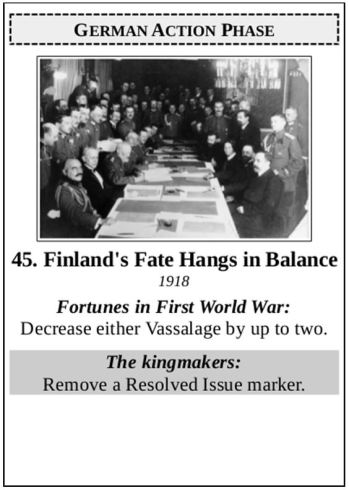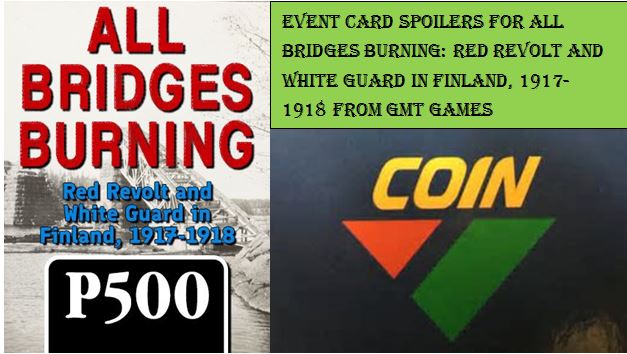For those that may not have seen the first few posts in this new feature, we have asked the designer of All Bridges Burning:Red Revolt and White Guard in Finland, 1917-1918 from GMT Games VPJ Arponen, to provide us with text of some of the proposed Event Cards and also to give a short summary of the historical background as well as their use in the game. We will plan to post these Spoilers every 7-10 days over the next few months, or even longer if Vez is up for it. We are very grateful for Vez and his willingness to do this for us and for our readers. Thank you for your hard work Vez!
In our 6th Event Card Spoiler post regarding All Bridges Burning, we take a look at card #45 Finland’s Fate Hangs in Balance. Please keep in mind that the artwork and layout of these cards is not yet finalized and is only for playtest purposes at this point. Also, as the game is still in development, card details may still change prior to publication.
45. Finland’s Fate Hangs in Balance

This is an event firmly in the good old COIN Series tradition of game changing events. This cuts in a number of ways.
For one, in my other posts on All Bridges Burning, I’ve talked about the dilemma faced by the Senate player in All Bridges Burning regarding acquiring German assistance in the military effort of ousting the Reds. On the one hand, the Germans who move on the map as a group of three cubes (troops) are a bit of a Death Star for the Reds and the German fire power is unparalleled in the game. The Senate player will know this and be accordingly tempted to encourage the German presence.
The catch, however, is that the Germans aren’t going to just give the Senate their country back once they’ve been invited in. In the game mechanical terms, a too high level of German participation may make it impossible for the Senate to fulfill one part of their victory conditions. The unshaded part of the event provides the Senate a way to cut themselves free of German influence.
Historically, the German arrival in Finland was part of their geopolitical maneuvering against Russia in the context of WW1. The Finnish historian Seppo Hentilä wrote:
Sending troops to Finland was on the Germans’ agenda even in mid-February 1918, but only when it suited their plans: they broke the armistice with Russia, and to improve their strategic position decided to send ‘military expeditions’ to the Ukraine, the Baltic lands and Finland to crush the Bolshevik revolution on the Russian periphery. But in order to implement this plan, Germany needed a request for help from Finland. Accordingly, on 14 February the representatives of the Vaasa Senate in Berlin, Edvart Hjelt and Rafael Erich, presented a memo to the German high command, without reference to the Senate, let alone its permission, requesting the dispatch of troops to Finland ‘to save [our] fatherland from imminent defeat’. A week later Germany announced that it consented to the Finnish request. Thus Germany had in effect invited itself to go to the aid of White Finland. (Jussila et al 1999. From Grand Dutchy to a Modern State. Hurst & Company, London. Pages 116-117.)
Evidently the German plan was to absorb Finland in the German sphere of political and economic influence, as Hentilä explains:
In fact, Hjelt and Erich were obliged to sign, on 7 March [1918], three agreements with Germany that were most disadvantageous to Finland […] Finland was not permitted to concede any privileges to a third party without first referring the matter to Germany. With the trade and maritime agreement, Finland granted Germany economic preference. The secret cost assurance, which was confirmed by an exchange of diplomatic notes, effectively made Finland a German military bridgehead: it would be obliged, when required, to grant Germany the right to establish bases for its naval forces ‘anywhere within Finnish territory’.”
The unshaded part of the event gives the Senate a great opportunity of largely severing ties to Germany. Yet, depending on exactly when the event pops up in the course of play, it may come at the price of having to give up the military muscle that the Germans provide in the game. The severing of the ties simulates the counterfactual situation that the German war effort in WW1 had collapsed about six to nine months earlier than it historically did. Historically, the Germans exited WW1 in November 1918 – the Finnish Civil War had ended in May 1918. The German collapse also saw them withdraw their forces, and thereby their influence, from Finland.
Card image used: Bundesarchiv
You can also catch up on the series by following these links:
#3 November Revolution in Russia
#9 Declaration of Finnish Independence
#27 The Reds Launch a Major Offensive

If you are interested in All Bridges Burning: Red Revolt and White Guard in Finland, 1917-1918, you can pre-order a copy at the following link: https://www.gmtgames.com/p-675-all-bridges-burning-red-revolt-and-white-guard-in-finland-1917-1918.aspx
Also, check out our interview with the designer VPJ Arponen to get better insight into the game.
-Grant
